Report on Business Environment, Structure, and Analysis (Tesco)
VerifiedAdded on 2023/01/13
|17
|5350
|70
Report
AI Summary
This report provides a comprehensive analysis of the business environment, focusing on Tesco, BBC, and Oxfam. It begins with a critical examination of different business structures, including profitable, non-profitable, and non-governmental organizations, as well as micro, small, and medium-sized enterprises. The report delves into the legal structures of these organizations and explores how their size, scope, and legal frameworks align with their objectives, products, and services. Activity 1 also examines the interrelationships between various organizational functions and their connection to organizational structure and goals. Activity 2 utilizes PESTLE analysis for macro-environmental analysis, Porter's Five Forces for micro-environmental analysis, VRIO for assessing organizational strengths and weaknesses, and SWOT analysis for strategic planning. The report culminates in a TWOS matrix analysis, integrating strengths and weaknesses with micro and macro factors to inform strategic business decisions. The report provides a thorough understanding of how these factors impact business operations and strategic planning.
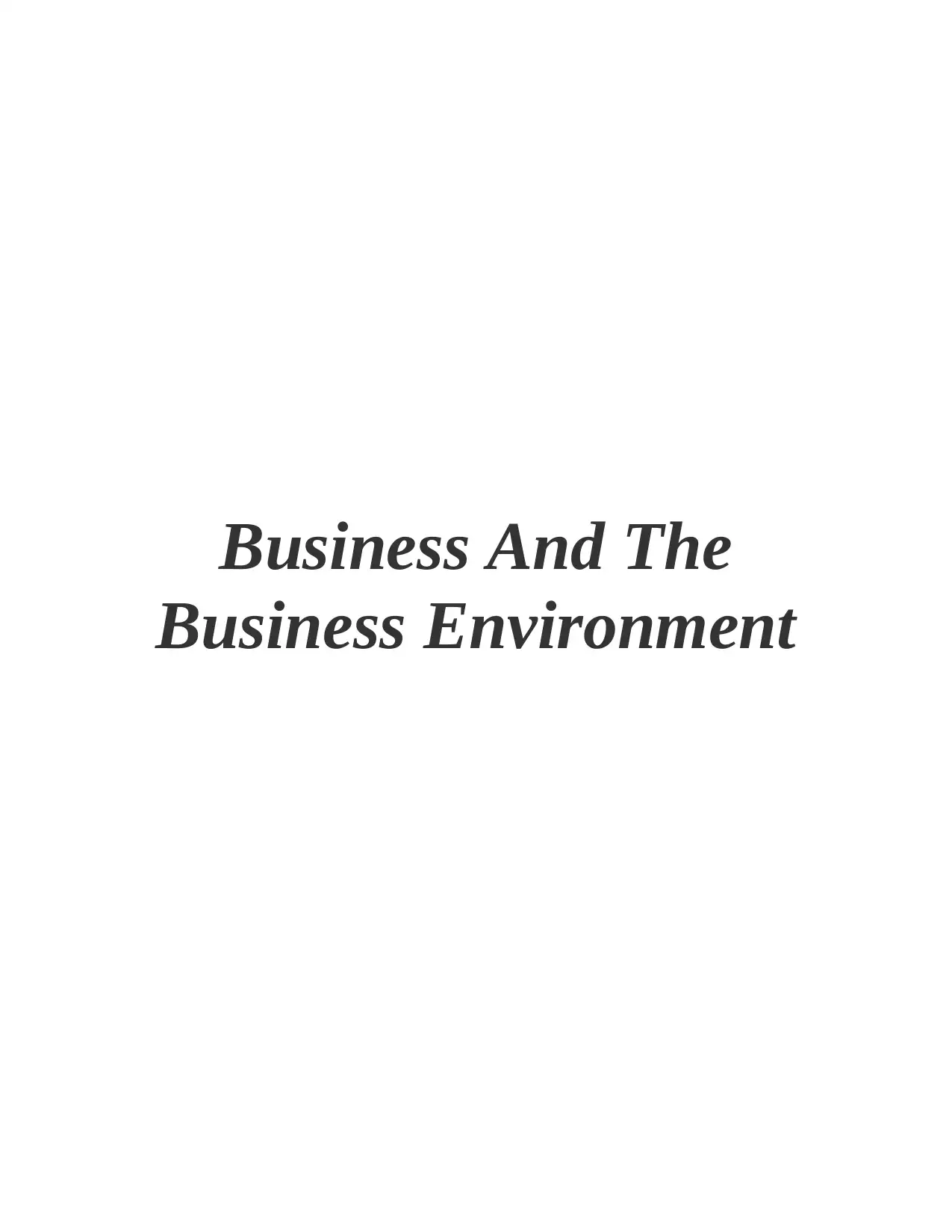
Business And The
Business Environment
Business Environment
Paraphrase This Document
Need a fresh take? Get an instant paraphrase of this document with our AI Paraphraser
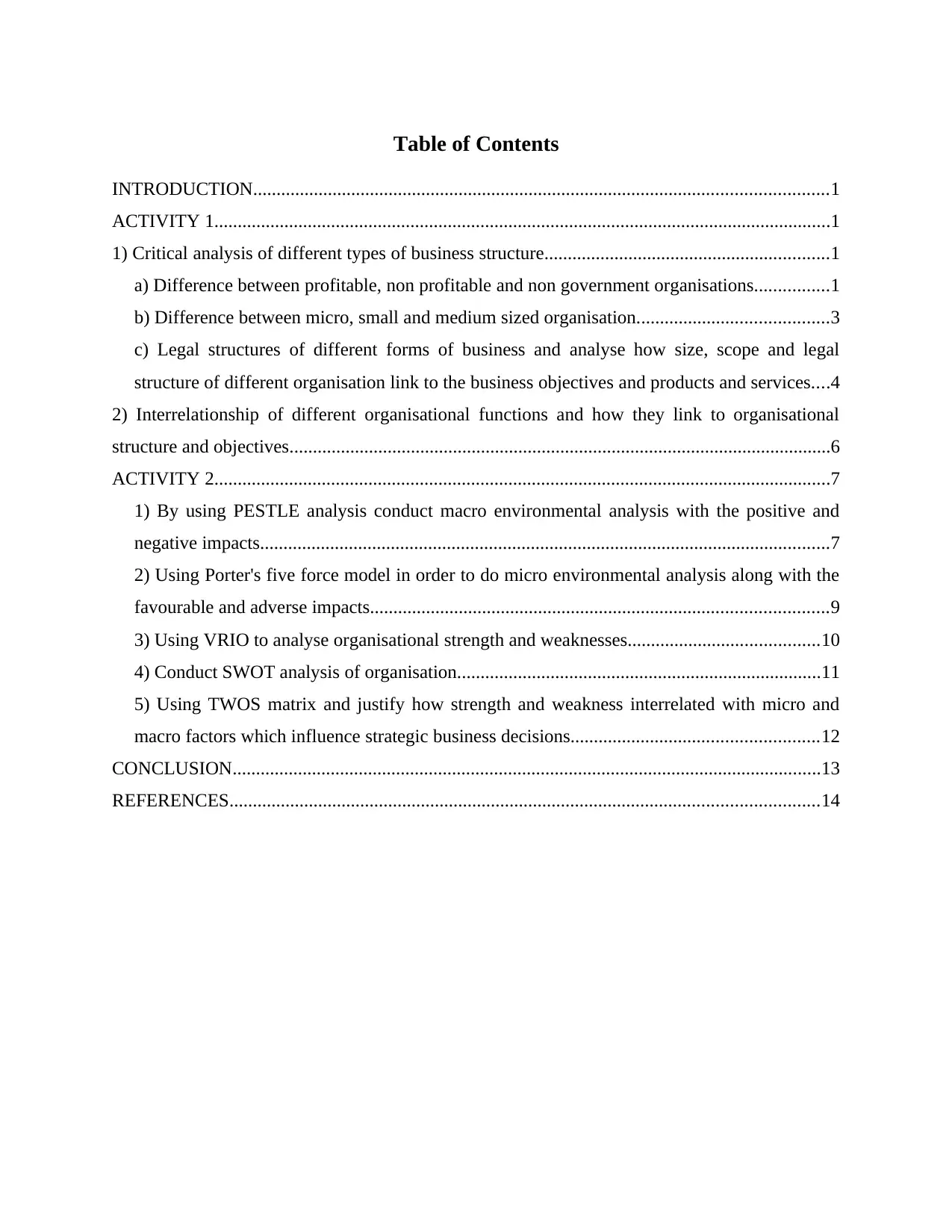
Table of Contents
INTRODUCTION...........................................................................................................................1
ACTIVITY 1....................................................................................................................................1
1) Critical analysis of different types of business structure.............................................................1
a) Difference between profitable, non profitable and non government organisations................1
b) Difference between micro, small and medium sized organisation.........................................3
c) Legal structures of different forms of business and analyse how size, scope and legal
structure of different organisation link to the business objectives and products and services....4
2) Interrelationship of different organisational functions and how they link to organisational
structure and objectives....................................................................................................................6
ACTIVITY 2....................................................................................................................................7
1) By using PESTLE analysis conduct macro environmental analysis with the positive and
negative impacts..........................................................................................................................7
2) Using Porter's five force model in order to do micro environmental analysis along with the
favourable and adverse impacts..................................................................................................9
3) Using VRIO to analyse organisational strength and weaknesses.........................................10
4) Conduct SWOT analysis of organisation..............................................................................11
5) Using TWOS matrix and justify how strength and weakness interrelated with micro and
macro factors which influence strategic business decisions.....................................................12
CONCLUSION..............................................................................................................................13
REFERENCES..............................................................................................................................14
INTRODUCTION...........................................................................................................................1
ACTIVITY 1....................................................................................................................................1
1) Critical analysis of different types of business structure.............................................................1
a) Difference between profitable, non profitable and non government organisations................1
b) Difference between micro, small and medium sized organisation.........................................3
c) Legal structures of different forms of business and analyse how size, scope and legal
structure of different organisation link to the business objectives and products and services....4
2) Interrelationship of different organisational functions and how they link to organisational
structure and objectives....................................................................................................................6
ACTIVITY 2....................................................................................................................................7
1) By using PESTLE analysis conduct macro environmental analysis with the positive and
negative impacts..........................................................................................................................7
2) Using Porter's five force model in order to do micro environmental analysis along with the
favourable and adverse impacts..................................................................................................9
3) Using VRIO to analyse organisational strength and weaknesses.........................................10
4) Conduct SWOT analysis of organisation..............................................................................11
5) Using TWOS matrix and justify how strength and weakness interrelated with micro and
macro factors which influence strategic business decisions.....................................................12
CONCLUSION..............................................................................................................................13
REFERENCES..............................................................................................................................14
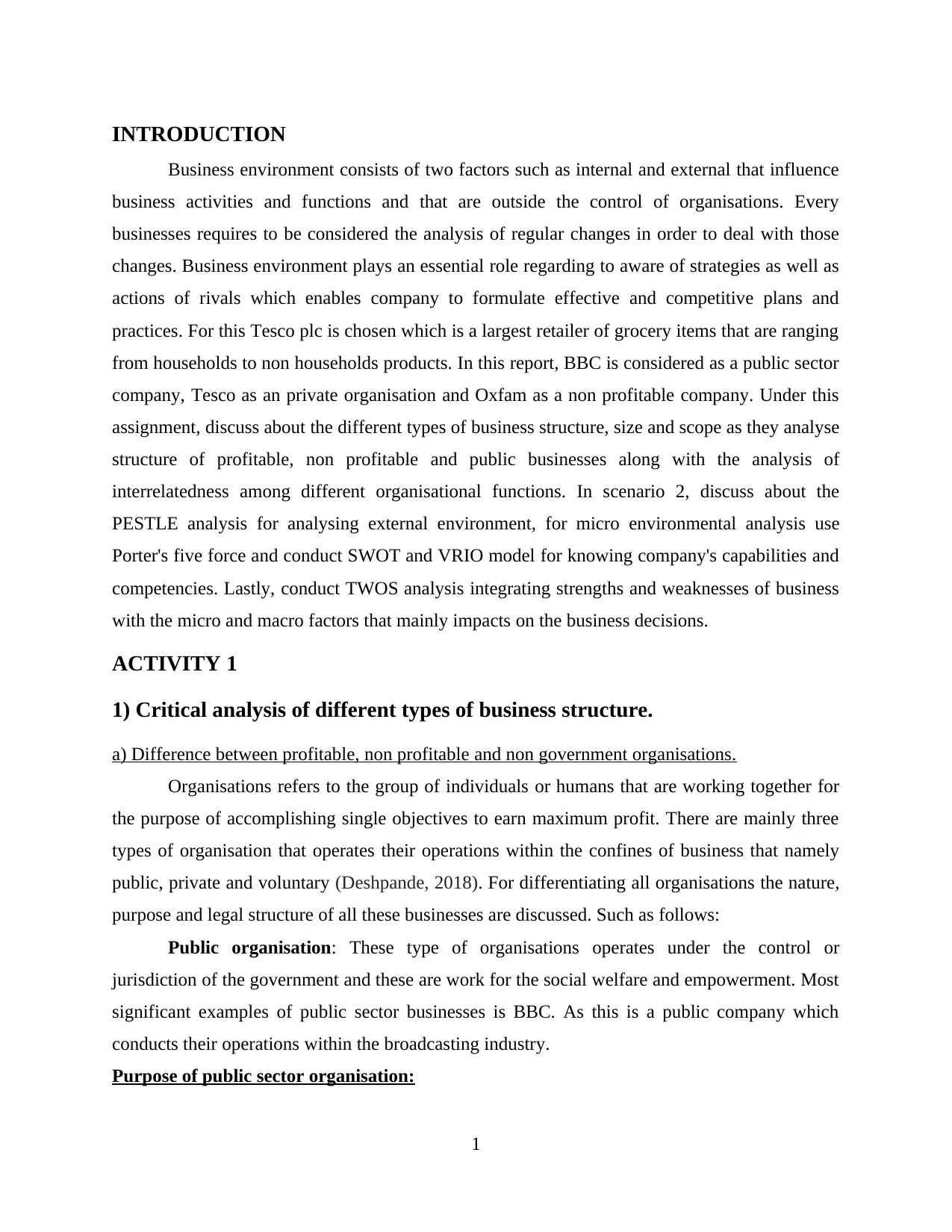
INTRODUCTION
Business environment consists of two factors such as internal and external that influence
business activities and functions and that are outside the control of organisations. Every
businesses requires to be considered the analysis of regular changes in order to deal with those
changes. Business environment plays an essential role regarding to aware of strategies as well as
actions of rivals which enables company to formulate effective and competitive plans and
practices. For this Tesco plc is chosen which is a largest retailer of grocery items that are ranging
from households to non households products. In this report, BBC is considered as a public sector
company, Tesco as an private organisation and Oxfam as a non profitable company. Under this
assignment, discuss about the different types of business structure, size and scope as they analyse
structure of profitable, non profitable and public businesses along with the analysis of
interrelatedness among different organisational functions. In scenario 2, discuss about the
PESTLE analysis for analysing external environment, for micro environmental analysis use
Porter's five force and conduct SWOT and VRIO model for knowing company's capabilities and
competencies. Lastly, conduct TWOS analysis integrating strengths and weaknesses of business
with the micro and macro factors that mainly impacts on the business decisions.
ACTIVITY 1
1) Critical analysis of different types of business structure.
a) Difference between profitable, non profitable and non government organisations.
Organisations refers to the group of individuals or humans that are working together for
the purpose of accomplishing single objectives to earn maximum profit. There are mainly three
types of organisation that operates their operations within the confines of business that namely
public, private and voluntary (Deshpande, 2018). For differentiating all organisations the nature,
purpose and legal structure of all these businesses are discussed. Such as follows:
Public organisation: These type of organisations operates under the control or
jurisdiction of the government and these are work for the social welfare and empowerment. Most
significant examples of public sector businesses is BBC. As this is a public company which
conducts their operations within the broadcasting industry.
Purpose of public sector organisation:
1
Business environment consists of two factors such as internal and external that influence
business activities and functions and that are outside the control of organisations. Every
businesses requires to be considered the analysis of regular changes in order to deal with those
changes. Business environment plays an essential role regarding to aware of strategies as well as
actions of rivals which enables company to formulate effective and competitive plans and
practices. For this Tesco plc is chosen which is a largest retailer of grocery items that are ranging
from households to non households products. In this report, BBC is considered as a public sector
company, Tesco as an private organisation and Oxfam as a non profitable company. Under this
assignment, discuss about the different types of business structure, size and scope as they analyse
structure of profitable, non profitable and public businesses along with the analysis of
interrelatedness among different organisational functions. In scenario 2, discuss about the
PESTLE analysis for analysing external environment, for micro environmental analysis use
Porter's five force and conduct SWOT and VRIO model for knowing company's capabilities and
competencies. Lastly, conduct TWOS analysis integrating strengths and weaknesses of business
with the micro and macro factors that mainly impacts on the business decisions.
ACTIVITY 1
1) Critical analysis of different types of business structure.
a) Difference between profitable, non profitable and non government organisations.
Organisations refers to the group of individuals or humans that are working together for
the purpose of accomplishing single objectives to earn maximum profit. There are mainly three
types of organisation that operates their operations within the confines of business that namely
public, private and voluntary (Deshpande, 2018). For differentiating all organisations the nature,
purpose and legal structure of all these businesses are discussed. Such as follows:
Public organisation: These type of organisations operates under the control or
jurisdiction of the government and these are work for the social welfare and empowerment. Most
significant examples of public sector businesses is BBC. As this is a public company which
conducts their operations within the broadcasting industry.
Purpose of public sector organisation:
1
⊘ This is a preview!⊘
Do you want full access?
Subscribe today to unlock all pages.

Trusted by 1+ million students worldwide
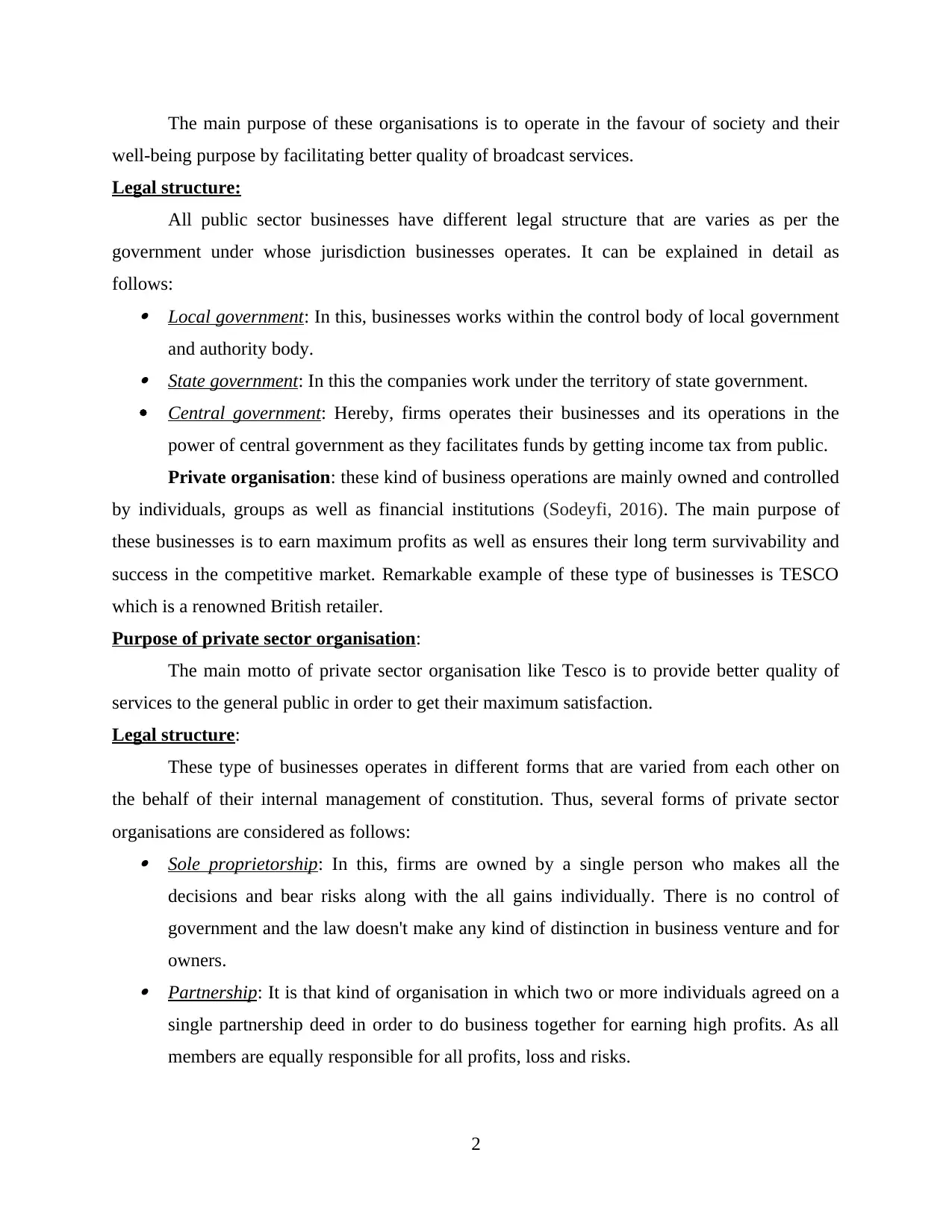
The main purpose of these organisations is to operate in the favour of society and their
well-being purpose by facilitating better quality of broadcast services.
Legal structure:
All public sector businesses have different legal structure that are varies as per the
government under whose jurisdiction businesses operates. It can be explained in detail as
follows: Local government: In this, businesses works within the control body of local government
and authority body. State government: In this the companies work under the territory of state government.
Central government: Hereby, firms operates their businesses and its operations in the
power of central government as they facilitates funds by getting income tax from public.
Private organisation: these kind of business operations are mainly owned and controlled
by individuals, groups as well as financial institutions (Sodeyfi, 2016). The main purpose of
these businesses is to earn maximum profits as well as ensures their long term survivability and
success in the competitive market. Remarkable example of these type of businesses is TESCO
which is a renowned British retailer.
Purpose of private sector organisation:
The main motto of private sector organisation like Tesco is to provide better quality of
services to the general public in order to get their maximum satisfaction.
Legal structure:
These type of businesses operates in different forms that are varied from each other on
the behalf of their internal management of constitution. Thus, several forms of private sector
organisations are considered as follows: Sole proprietorship: In this, firms are owned by a single person who makes all the
decisions and bear risks along with the all gains individually. There is no control of
government and the law doesn't make any kind of distinction in business venture and for
owners. Partnership: It is that kind of organisation in which two or more individuals agreed on a
single partnership deed in order to do business together for earning high profits. As all
members are equally responsible for all profits, loss and risks.
2
well-being purpose by facilitating better quality of broadcast services.
Legal structure:
All public sector businesses have different legal structure that are varies as per the
government under whose jurisdiction businesses operates. It can be explained in detail as
follows: Local government: In this, businesses works within the control body of local government
and authority body. State government: In this the companies work under the territory of state government.
Central government: Hereby, firms operates their businesses and its operations in the
power of central government as they facilitates funds by getting income tax from public.
Private organisation: these kind of business operations are mainly owned and controlled
by individuals, groups as well as financial institutions (Sodeyfi, 2016). The main purpose of
these businesses is to earn maximum profits as well as ensures their long term survivability and
success in the competitive market. Remarkable example of these type of businesses is TESCO
which is a renowned British retailer.
Purpose of private sector organisation:
The main motto of private sector organisation like Tesco is to provide better quality of
services to the general public in order to get their maximum satisfaction.
Legal structure:
These type of businesses operates in different forms that are varied from each other on
the behalf of their internal management of constitution. Thus, several forms of private sector
organisations are considered as follows: Sole proprietorship: In this, firms are owned by a single person who makes all the
decisions and bear risks along with the all gains individually. There is no control of
government and the law doesn't make any kind of distinction in business venture and for
owners. Partnership: It is that kind of organisation in which two or more individuals agreed on a
single partnership deed in order to do business together for earning high profits. As all
members are equally responsible for all profits, loss and risks.
2
Paraphrase This Document
Need a fresh take? Get an instant paraphrase of this document with our AI Paraphraser
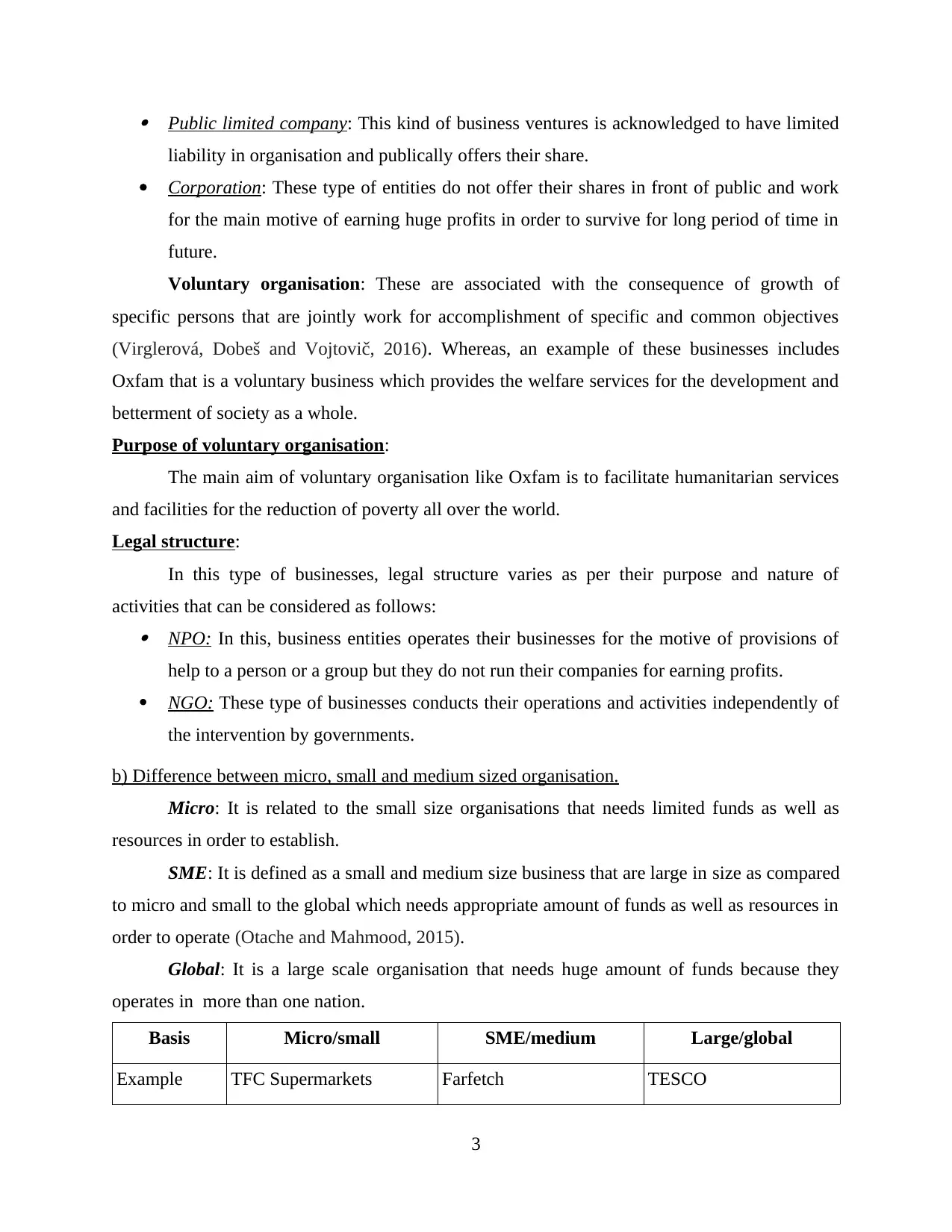
Public limited company: This kind of business ventures is acknowledged to have limited
liability in organisation and publically offers their share.
Corporation: These type of entities do not offer their shares in front of public and work
for the main motive of earning huge profits in order to survive for long period of time in
future.
Voluntary organisation: These are associated with the consequence of growth of
specific persons that are jointly work for accomplishment of specific and common objectives
(Virglerová, Dobeš and Vojtovič, 2016). Whereas, an example of these businesses includes
Oxfam that is a voluntary business which provides the welfare services for the development and
betterment of society as a whole.
Purpose of voluntary organisation:
The main aim of voluntary organisation like Oxfam is to facilitate humanitarian services
and facilities for the reduction of poverty all over the world.
Legal structure:
In this type of businesses, legal structure varies as per their purpose and nature of
activities that can be considered as follows: NPO: In this, business entities operates their businesses for the motive of provisions of
help to a person or a group but they do not run their companies for earning profits.
NGO: These type of businesses conducts their operations and activities independently of
the intervention by governments.
b) Difference between micro, small and medium sized organisation.
Micro: It is related to the small size organisations that needs limited funds as well as
resources in order to establish.
SME: It is defined as a small and medium size business that are large in size as compared
to micro and small to the global which needs appropriate amount of funds as well as resources in
order to operate (Otache and Mahmood, 2015).
Global: It is a large scale organisation that needs huge amount of funds because they
operates in more than one nation.
Basis Micro/small SME/medium Large/global
Example TFC Supermarkets Farfetch TESCO
3
liability in organisation and publically offers their share.
Corporation: These type of entities do not offer their shares in front of public and work
for the main motive of earning huge profits in order to survive for long period of time in
future.
Voluntary organisation: These are associated with the consequence of growth of
specific persons that are jointly work for accomplishment of specific and common objectives
(Virglerová, Dobeš and Vojtovič, 2016). Whereas, an example of these businesses includes
Oxfam that is a voluntary business which provides the welfare services for the development and
betterment of society as a whole.
Purpose of voluntary organisation:
The main aim of voluntary organisation like Oxfam is to facilitate humanitarian services
and facilities for the reduction of poverty all over the world.
Legal structure:
In this type of businesses, legal structure varies as per their purpose and nature of
activities that can be considered as follows: NPO: In this, business entities operates their businesses for the motive of provisions of
help to a person or a group but they do not run their companies for earning profits.
NGO: These type of businesses conducts their operations and activities independently of
the intervention by governments.
b) Difference between micro, small and medium sized organisation.
Micro: It is related to the small size organisations that needs limited funds as well as
resources in order to establish.
SME: It is defined as a small and medium size business that are large in size as compared
to micro and small to the global which needs appropriate amount of funds as well as resources in
order to operate (Otache and Mahmood, 2015).
Global: It is a large scale organisation that needs huge amount of funds because they
operates in more than one nation.
Basis Micro/small SME/medium Large/global
Example TFC Supermarkets Farfetch TESCO
3
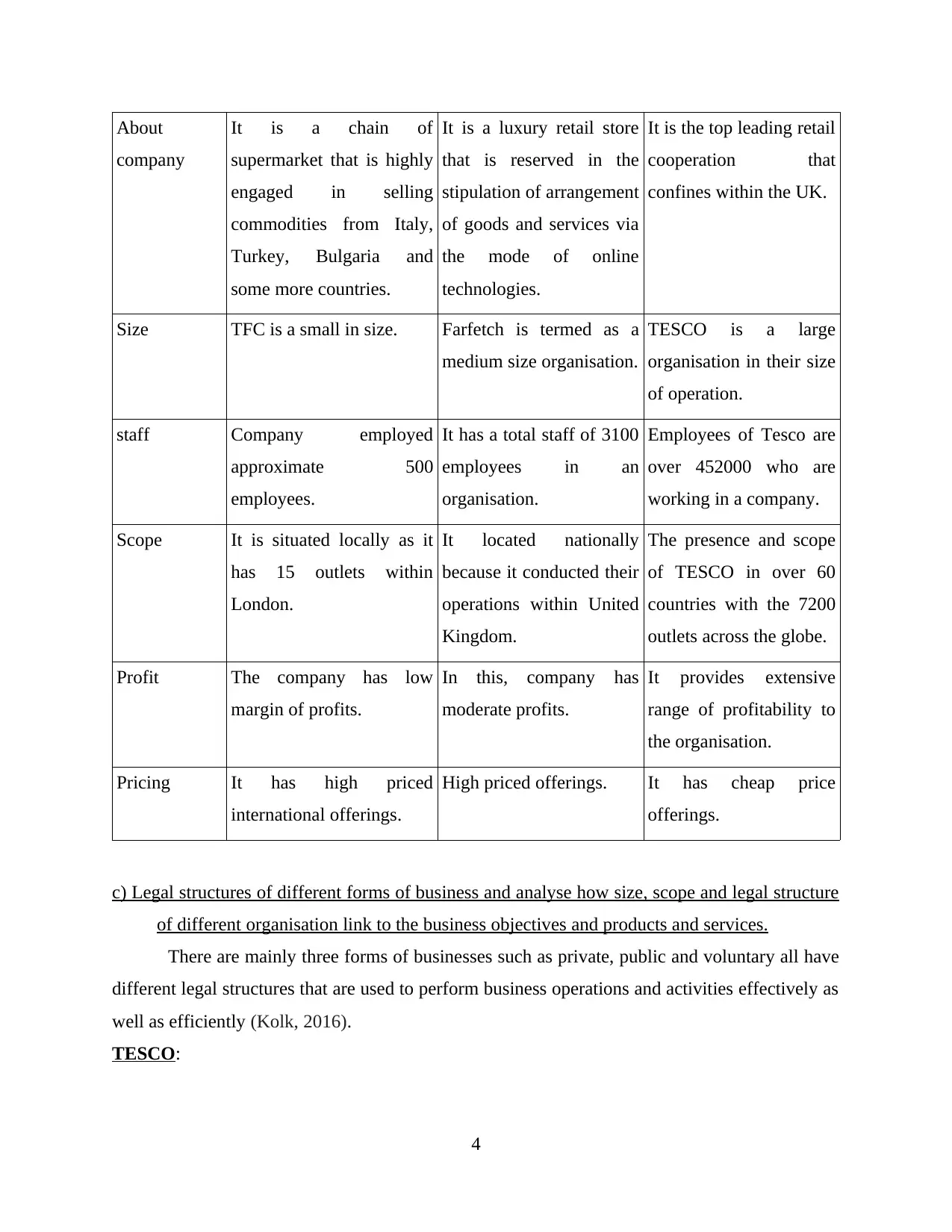
About
company
It is a chain of
supermarket that is highly
engaged in selling
commodities from Italy,
Turkey, Bulgaria and
some more countries.
It is a luxury retail store
that is reserved in the
stipulation of arrangement
of goods and services via
the mode of online
technologies.
It is the top leading retail
cooperation that
confines within the UK.
Size TFC is a small in size. Farfetch is termed as a
medium size organisation.
TESCO is a large
organisation in their size
of operation.
staff Company employed
approximate 500
employees.
It has a total staff of 3100
employees in an
organisation.
Employees of Tesco are
over 452000 who are
working in a company.
Scope It is situated locally as it
has 15 outlets within
London.
It located nationally
because it conducted their
operations within United
Kingdom.
The presence and scope
of TESCO in over 60
countries with the 7200
outlets across the globe.
Profit The company has low
margin of profits.
In this, company has
moderate profits.
It provides extensive
range of profitability to
the organisation.
Pricing It has high priced
international offerings.
High priced offerings. It has cheap price
offerings.
c) Legal structures of different forms of business and analyse how size, scope and legal structure
of different organisation link to the business objectives and products and services.
There are mainly three forms of businesses such as private, public and voluntary all have
different legal structures that are used to perform business operations and activities effectively as
well as efficiently (Kolk, 2016).
TESCO:
4
company
It is a chain of
supermarket that is highly
engaged in selling
commodities from Italy,
Turkey, Bulgaria and
some more countries.
It is a luxury retail store
that is reserved in the
stipulation of arrangement
of goods and services via
the mode of online
technologies.
It is the top leading retail
cooperation that
confines within the UK.
Size TFC is a small in size. Farfetch is termed as a
medium size organisation.
TESCO is a large
organisation in their size
of operation.
staff Company employed
approximate 500
employees.
It has a total staff of 3100
employees in an
organisation.
Employees of Tesco are
over 452000 who are
working in a company.
Scope It is situated locally as it
has 15 outlets within
London.
It located nationally
because it conducted their
operations within United
Kingdom.
The presence and scope
of TESCO in over 60
countries with the 7200
outlets across the globe.
Profit The company has low
margin of profits.
In this, company has
moderate profits.
It provides extensive
range of profitability to
the organisation.
Pricing It has high priced
international offerings.
High priced offerings. It has cheap price
offerings.
c) Legal structures of different forms of business and analyse how size, scope and legal structure
of different organisation link to the business objectives and products and services.
There are mainly three forms of businesses such as private, public and voluntary all have
different legal structures that are used to perform business operations and activities effectively as
well as efficiently (Kolk, 2016).
TESCO:
4
⊘ This is a preview!⊘
Do you want full access?
Subscribe today to unlock all pages.

Trusted by 1+ million students worldwide
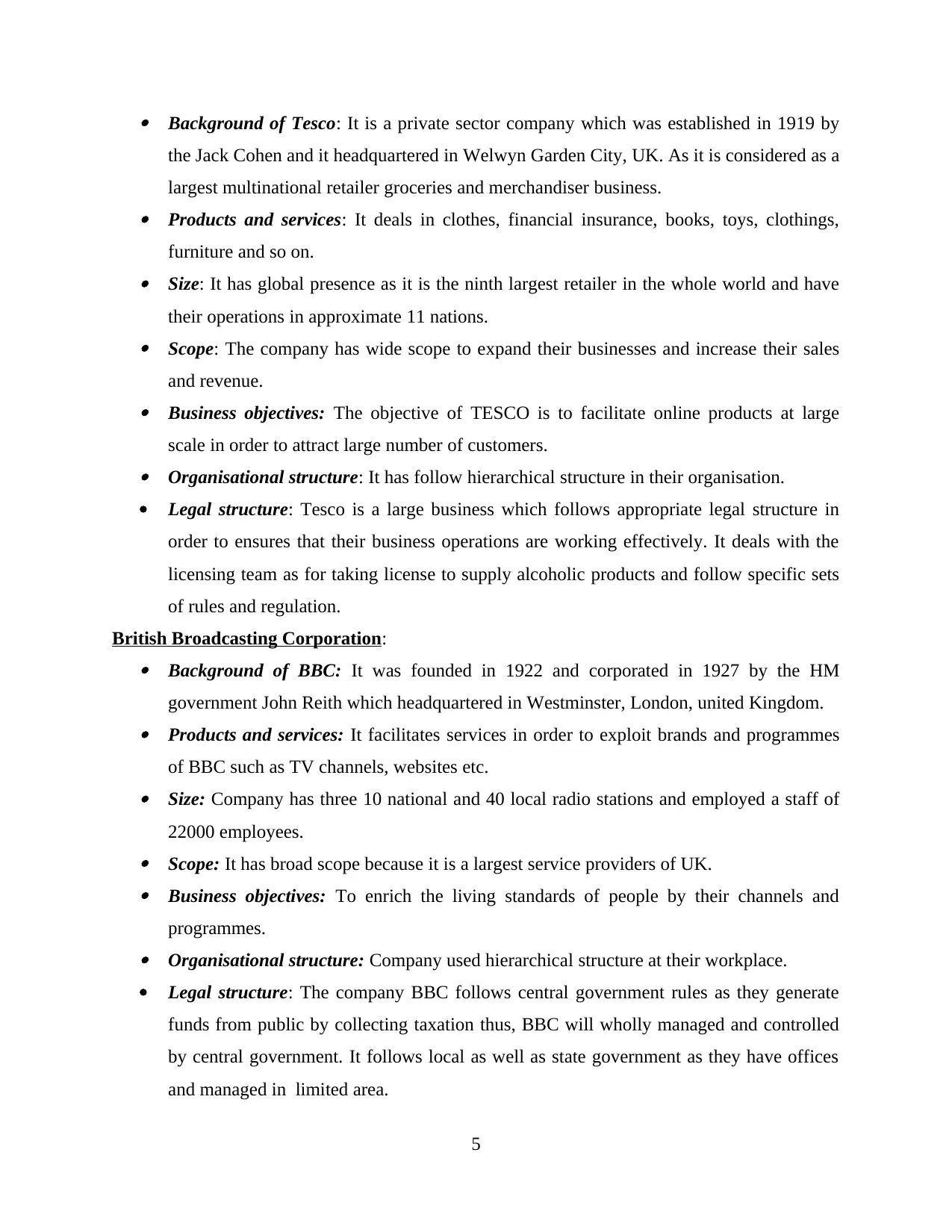
Background of Tesco: It is a private sector company which was established in 1919 by
the Jack Cohen and it headquartered in Welwyn Garden City, UK. As it is considered as a
largest multinational retailer groceries and merchandiser business. Products and services: It deals in clothes, financial insurance, books, toys, clothings,
furniture and so on. Size: It has global presence as it is the ninth largest retailer in the whole world and have
their operations in approximate 11 nations. Scope: The company has wide scope to expand their businesses and increase their sales
and revenue. Business objectives: The objective of TESCO is to facilitate online products at large
scale in order to attract large number of customers. Organisational structure: It has follow hierarchical structure in their organisation.
Legal structure: Tesco is a large business which follows appropriate legal structure in
order to ensures that their business operations are working effectively. It deals with the
licensing team as for taking license to supply alcoholic products and follow specific sets
of rules and regulation.
British Broadcasting Corporation: Background of BBC: It was founded in 1922 and corporated in 1927 by the HM
government John Reith which headquartered in Westminster, London, united Kingdom. Products and services: It facilitates services in order to exploit brands and programmes
of BBC such as TV channels, websites etc. Size: Company has three 10 national and 40 local radio stations and employed a staff of
22000 employees. Scope: It has broad scope because it is a largest service providers of UK. Business objectives: To enrich the living standards of people by their channels and
programmes. Organisational structure: Company used hierarchical structure at their workplace.
Legal structure: The company BBC follows central government rules as they generate
funds from public by collecting taxation thus, BBC will wholly managed and controlled
by central government. It follows local as well as state government as they have offices
and managed in limited area.
5
the Jack Cohen and it headquartered in Welwyn Garden City, UK. As it is considered as a
largest multinational retailer groceries and merchandiser business. Products and services: It deals in clothes, financial insurance, books, toys, clothings,
furniture and so on. Size: It has global presence as it is the ninth largest retailer in the whole world and have
their operations in approximate 11 nations. Scope: The company has wide scope to expand their businesses and increase their sales
and revenue. Business objectives: The objective of TESCO is to facilitate online products at large
scale in order to attract large number of customers. Organisational structure: It has follow hierarchical structure in their organisation.
Legal structure: Tesco is a large business which follows appropriate legal structure in
order to ensures that their business operations are working effectively. It deals with the
licensing team as for taking license to supply alcoholic products and follow specific sets
of rules and regulation.
British Broadcasting Corporation: Background of BBC: It was founded in 1922 and corporated in 1927 by the HM
government John Reith which headquartered in Westminster, London, united Kingdom. Products and services: It facilitates services in order to exploit brands and programmes
of BBC such as TV channels, websites etc. Size: Company has three 10 national and 40 local radio stations and employed a staff of
22000 employees. Scope: It has broad scope because it is a largest service providers of UK. Business objectives: To enrich the living standards of people by their channels and
programmes. Organisational structure: Company used hierarchical structure at their workplace.
Legal structure: The company BBC follows central government rules as they generate
funds from public by collecting taxation thus, BBC will wholly managed and controlled
by central government. It follows local as well as state government as they have offices
and managed in limited area.
5
Paraphrase This Document
Need a fresh take? Get an instant paraphrase of this document with our AI Paraphraser
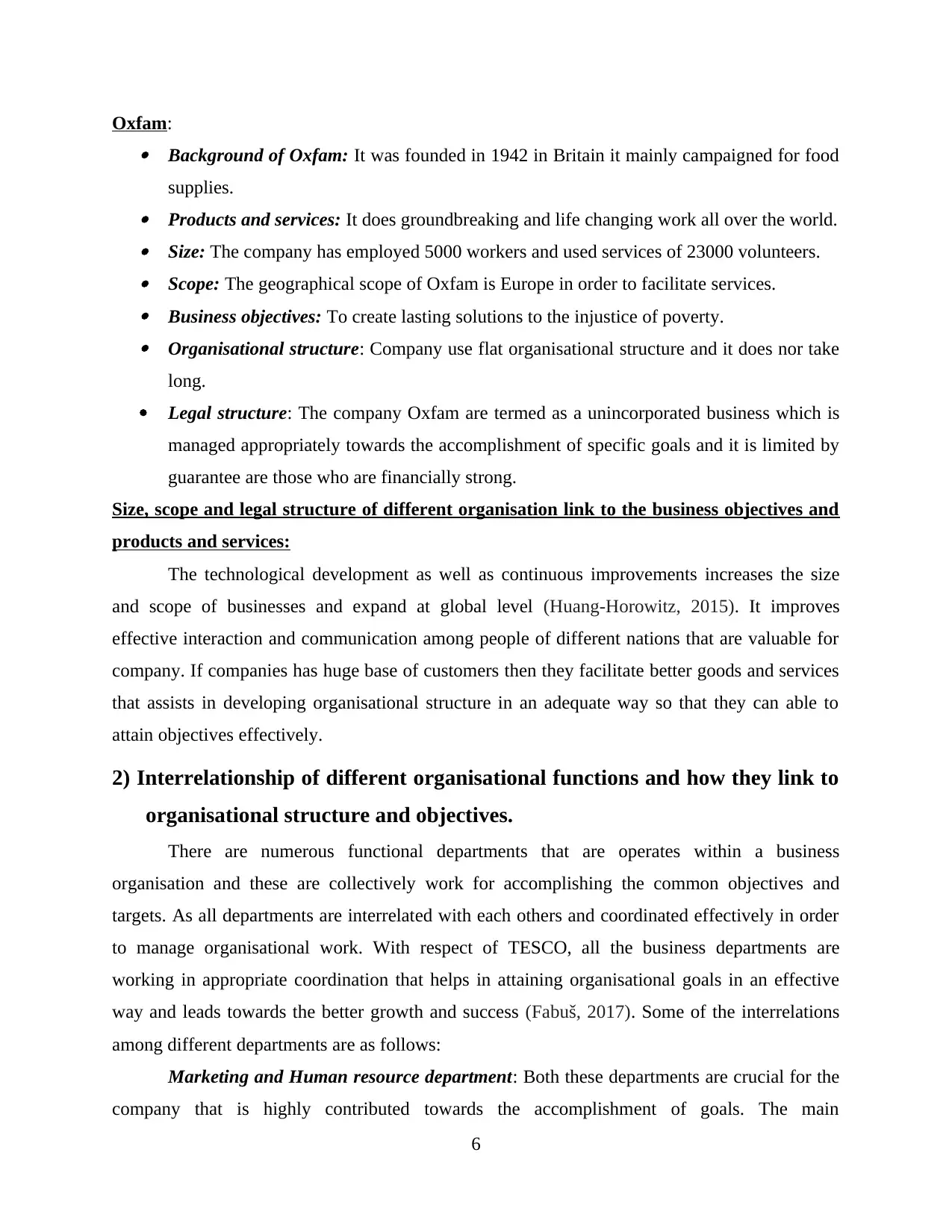
Oxfam: Background of Oxfam: It was founded in 1942 in Britain it mainly campaigned for food
supplies. Products and services: It does groundbreaking and life changing work all over the world. Size: The company has employed 5000 workers and used services of 23000 volunteers. Scope: The geographical scope of Oxfam is Europe in order to facilitate services. Business objectives: To create lasting solutions to the injustice of poverty. Organisational structure: Company use flat organisational structure and it does nor take
long.
Legal structure: The company Oxfam are termed as a unincorporated business which is
managed appropriately towards the accomplishment of specific goals and it is limited by
guarantee are those who are financially strong.
Size, scope and legal structure of different organisation link to the business objectives and
products and services:
The technological development as well as continuous improvements increases the size
and scope of businesses and expand at global level (Huang-Horowitz, 2015). It improves
effective interaction and communication among people of different nations that are valuable for
company. If companies has huge base of customers then they facilitate better goods and services
that assists in developing organisational structure in an adequate way so that they can able to
attain objectives effectively.
2) Interrelationship of different organisational functions and how they link to
organisational structure and objectives.
There are numerous functional departments that are operates within a business
organisation and these are collectively work for accomplishing the common objectives and
targets. As all departments are interrelated with each others and coordinated effectively in order
to manage organisational work. With respect of TESCO, all the business departments are
working in appropriate coordination that helps in attaining organisational goals in an effective
way and leads towards the better growth and success (Fabuš, 2017). Some of the interrelations
among different departments are as follows:
Marketing and Human resource department: Both these departments are crucial for the
company that is highly contributed towards the accomplishment of goals. The main
6
supplies. Products and services: It does groundbreaking and life changing work all over the world. Size: The company has employed 5000 workers and used services of 23000 volunteers. Scope: The geographical scope of Oxfam is Europe in order to facilitate services. Business objectives: To create lasting solutions to the injustice of poverty. Organisational structure: Company use flat organisational structure and it does nor take
long.
Legal structure: The company Oxfam are termed as a unincorporated business which is
managed appropriately towards the accomplishment of specific goals and it is limited by
guarantee are those who are financially strong.
Size, scope and legal structure of different organisation link to the business objectives and
products and services:
The technological development as well as continuous improvements increases the size
and scope of businesses and expand at global level (Huang-Horowitz, 2015). It improves
effective interaction and communication among people of different nations that are valuable for
company. If companies has huge base of customers then they facilitate better goods and services
that assists in developing organisational structure in an adequate way so that they can able to
attain objectives effectively.
2) Interrelationship of different organisational functions and how they link to
organisational structure and objectives.
There are numerous functional departments that are operates within a business
organisation and these are collectively work for accomplishing the common objectives and
targets. As all departments are interrelated with each others and coordinated effectively in order
to manage organisational work. With respect of TESCO, all the business departments are
working in appropriate coordination that helps in attaining organisational goals in an effective
way and leads towards the better growth and success (Fabuš, 2017). Some of the interrelations
among different departments are as follows:
Marketing and Human resource department: Both these departments are crucial for the
company that is highly contributed towards the accomplishment of goals. The main
6
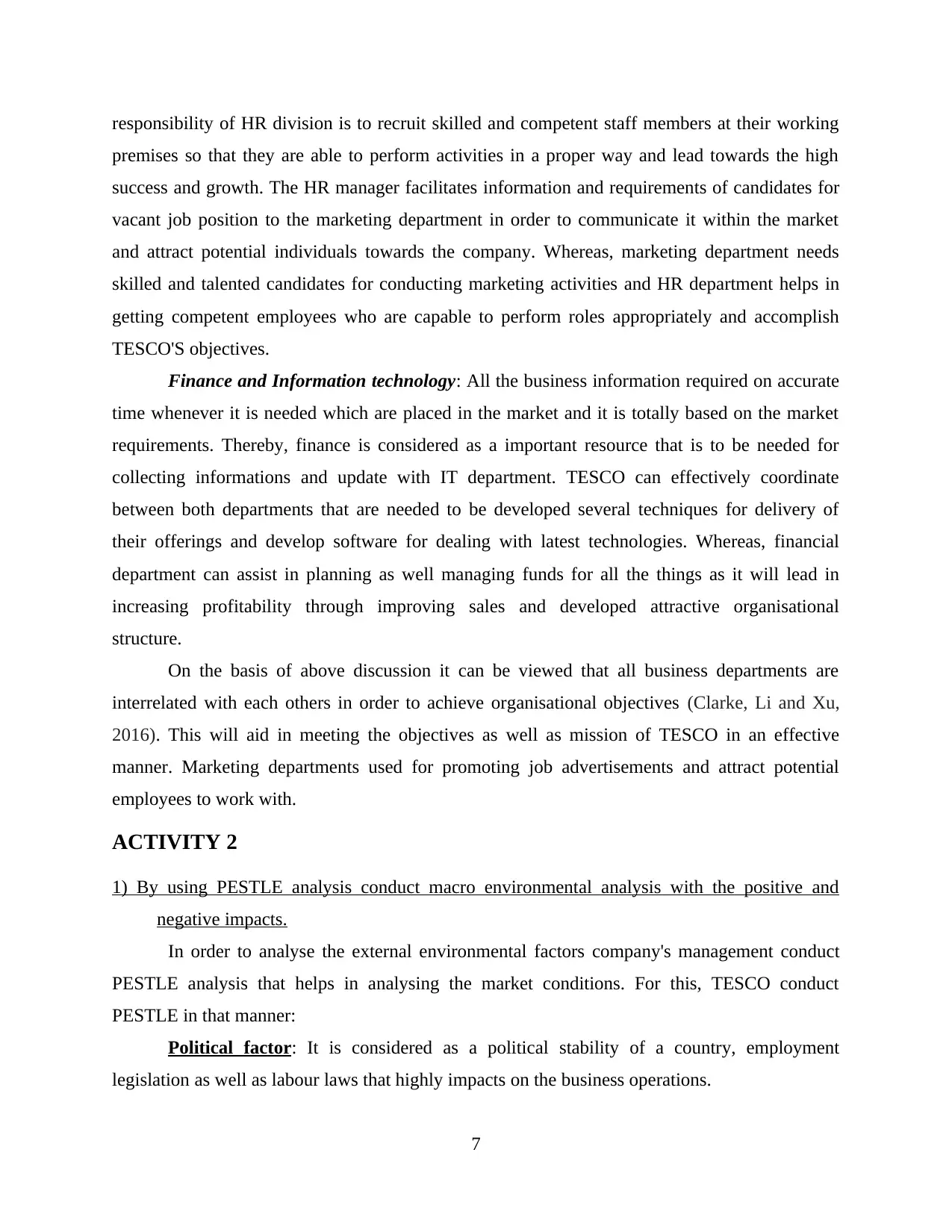
responsibility of HR division is to recruit skilled and competent staff members at their working
premises so that they are able to perform activities in a proper way and lead towards the high
success and growth. The HR manager facilitates information and requirements of candidates for
vacant job position to the marketing department in order to communicate it within the market
and attract potential individuals towards the company. Whereas, marketing department needs
skilled and talented candidates for conducting marketing activities and HR department helps in
getting competent employees who are capable to perform roles appropriately and accomplish
TESCO'S objectives.
Finance and Information technology: All the business information required on accurate
time whenever it is needed which are placed in the market and it is totally based on the market
requirements. Thereby, finance is considered as a important resource that is to be needed for
collecting informations and update with IT department. TESCO can effectively coordinate
between both departments that are needed to be developed several techniques for delivery of
their offerings and develop software for dealing with latest technologies. Whereas, financial
department can assist in planning as well managing funds for all the things as it will lead in
increasing profitability through improving sales and developed attractive organisational
structure.
On the basis of above discussion it can be viewed that all business departments are
interrelated with each others in order to achieve organisational objectives (Clarke, Li and Xu,
2016). This will aid in meeting the objectives as well as mission of TESCO in an effective
manner. Marketing departments used for promoting job advertisements and attract potential
employees to work with.
ACTIVITY 2
1) By using PESTLE analysis conduct macro environmental analysis with the positive and
negative impacts.
In order to analyse the external environmental factors company's management conduct
PESTLE analysis that helps in analysing the market conditions. For this, TESCO conduct
PESTLE in that manner:
Political factor: It is considered as a political stability of a country, employment
legislation as well as labour laws that highly impacts on the business operations.
7
premises so that they are able to perform activities in a proper way and lead towards the high
success and growth. The HR manager facilitates information and requirements of candidates for
vacant job position to the marketing department in order to communicate it within the market
and attract potential individuals towards the company. Whereas, marketing department needs
skilled and talented candidates for conducting marketing activities and HR department helps in
getting competent employees who are capable to perform roles appropriately and accomplish
TESCO'S objectives.
Finance and Information technology: All the business information required on accurate
time whenever it is needed which are placed in the market and it is totally based on the market
requirements. Thereby, finance is considered as a important resource that is to be needed for
collecting informations and update with IT department. TESCO can effectively coordinate
between both departments that are needed to be developed several techniques for delivery of
their offerings and develop software for dealing with latest technologies. Whereas, financial
department can assist in planning as well managing funds for all the things as it will lead in
increasing profitability through improving sales and developed attractive organisational
structure.
On the basis of above discussion it can be viewed that all business departments are
interrelated with each others in order to achieve organisational objectives (Clarke, Li and Xu,
2016). This will aid in meeting the objectives as well as mission of TESCO in an effective
manner. Marketing departments used for promoting job advertisements and attract potential
employees to work with.
ACTIVITY 2
1) By using PESTLE analysis conduct macro environmental analysis with the positive and
negative impacts.
In order to analyse the external environmental factors company's management conduct
PESTLE analysis that helps in analysing the market conditions. For this, TESCO conduct
PESTLE in that manner:
Political factor: It is considered as a political stability of a country, employment
legislation as well as labour laws that highly impacts on the business operations.
7
⊘ This is a preview!⊘
Do you want full access?
Subscribe today to unlock all pages.

Trusted by 1+ million students worldwide
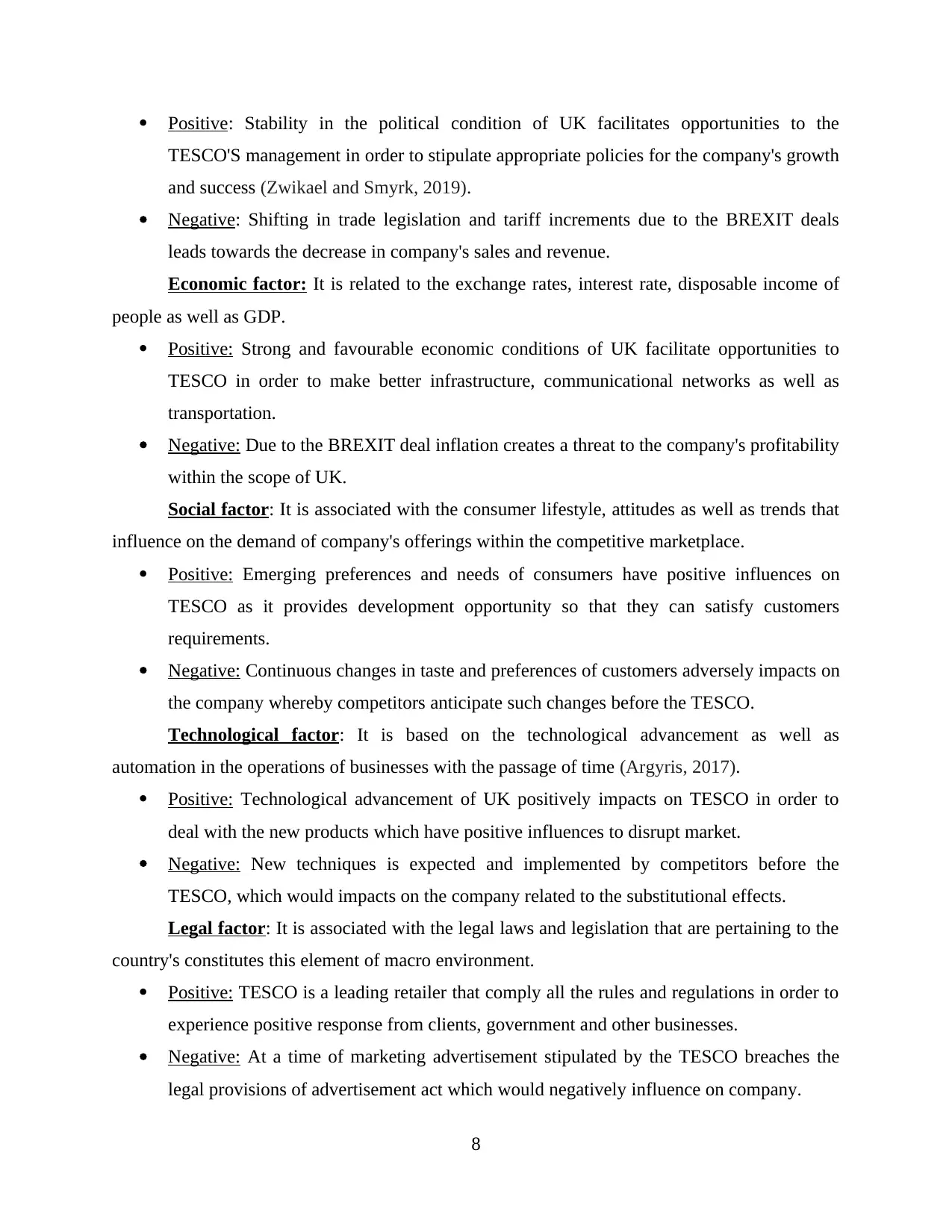
Positive: Stability in the political condition of UK facilitates opportunities to the
TESCO'S management in order to stipulate appropriate policies for the company's growth
and success (Zwikael and Smyrk, 2019).
Negative: Shifting in trade legislation and tariff increments due to the BREXIT deals
leads towards the decrease in company's sales and revenue.
Economic factor: It is related to the exchange rates, interest rate, disposable income of
people as well as GDP.
Positive: Strong and favourable economic conditions of UK facilitate opportunities to
TESCO in order to make better infrastructure, communicational networks as well as
transportation.
Negative: Due to the BREXIT deal inflation creates a threat to the company's profitability
within the scope of UK.
Social factor: It is associated with the consumer lifestyle, attitudes as well as trends that
influence on the demand of company's offerings within the competitive marketplace.
Positive: Emerging preferences and needs of consumers have positive influences on
TESCO as it provides development opportunity so that they can satisfy customers
requirements.
Negative: Continuous changes in taste and preferences of customers adversely impacts on
the company whereby competitors anticipate such changes before the TESCO.
Technological factor: It is based on the technological advancement as well as
automation in the operations of businesses with the passage of time (Argyris, 2017).
Positive: Technological advancement of UK positively impacts on TESCO in order to
deal with the new products which have positive influences to disrupt market.
Negative: New techniques is expected and implemented by competitors before the
TESCO, which would impacts on the company related to the substitutional effects.
Legal factor: It is associated with the legal laws and legislation that are pertaining to the
country's constitutes this element of macro environment.
Positive: TESCO is a leading retailer that comply all the rules and regulations in order to
experience positive response from clients, government and other businesses.
Negative: At a time of marketing advertisement stipulated by the TESCO breaches the
legal provisions of advertisement act which would negatively influence on company.
8
TESCO'S management in order to stipulate appropriate policies for the company's growth
and success (Zwikael and Smyrk, 2019).
Negative: Shifting in trade legislation and tariff increments due to the BREXIT deals
leads towards the decrease in company's sales and revenue.
Economic factor: It is related to the exchange rates, interest rate, disposable income of
people as well as GDP.
Positive: Strong and favourable economic conditions of UK facilitate opportunities to
TESCO in order to make better infrastructure, communicational networks as well as
transportation.
Negative: Due to the BREXIT deal inflation creates a threat to the company's profitability
within the scope of UK.
Social factor: It is associated with the consumer lifestyle, attitudes as well as trends that
influence on the demand of company's offerings within the competitive marketplace.
Positive: Emerging preferences and needs of consumers have positive influences on
TESCO as it provides development opportunity so that they can satisfy customers
requirements.
Negative: Continuous changes in taste and preferences of customers adversely impacts on
the company whereby competitors anticipate such changes before the TESCO.
Technological factor: It is based on the technological advancement as well as
automation in the operations of businesses with the passage of time (Argyris, 2017).
Positive: Technological advancement of UK positively impacts on TESCO in order to
deal with the new products which have positive influences to disrupt market.
Negative: New techniques is expected and implemented by competitors before the
TESCO, which would impacts on the company related to the substitutional effects.
Legal factor: It is associated with the legal laws and legislation that are pertaining to the
country's constitutes this element of macro environment.
Positive: TESCO is a leading retailer that comply all the rules and regulations in order to
experience positive response from clients, government and other businesses.
Negative: At a time of marketing advertisement stipulated by the TESCO breaches the
legal provisions of advertisement act which would negatively influence on company.
8
Paraphrase This Document
Need a fresh take? Get an instant paraphrase of this document with our AI Paraphraser
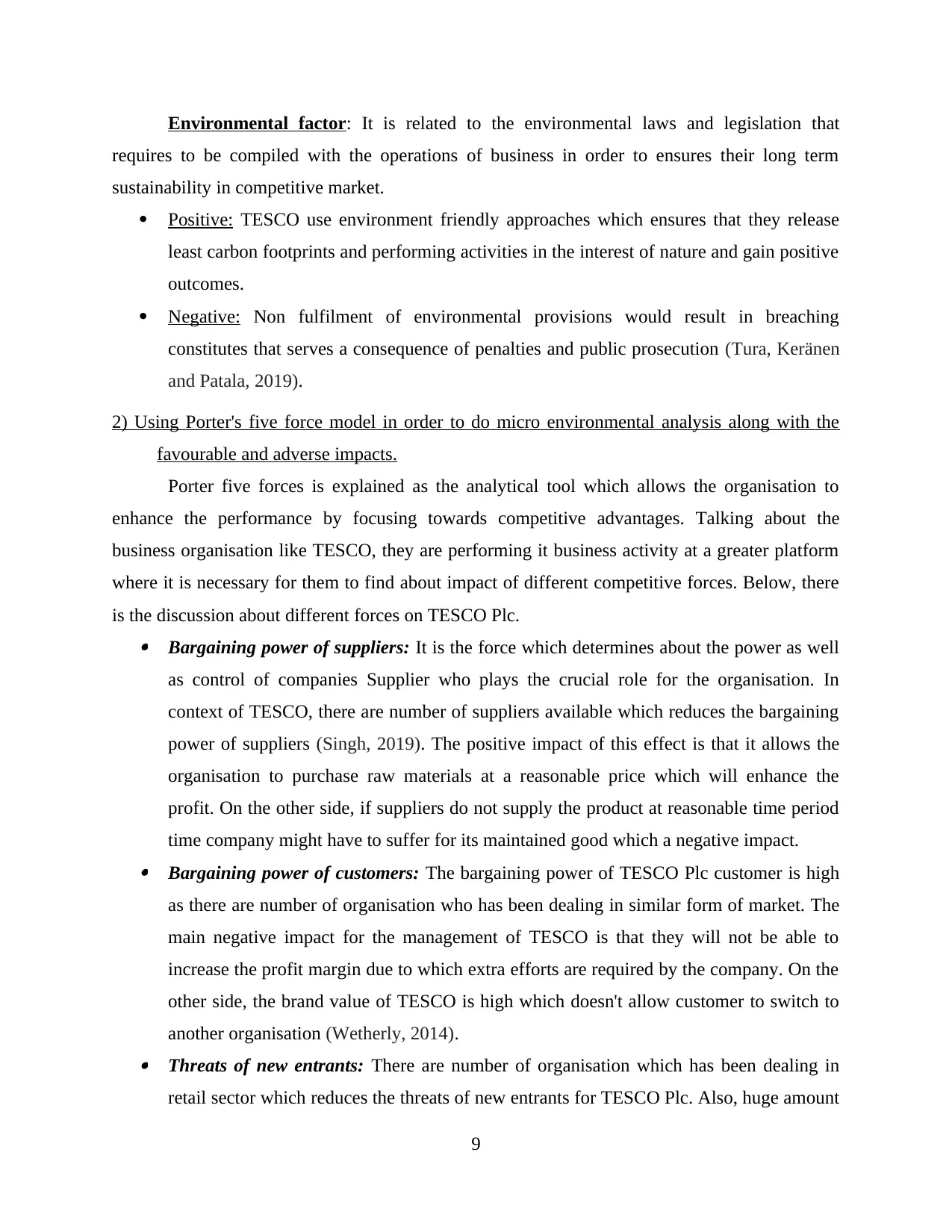
Environmental factor: It is related to the environmental laws and legislation that
requires to be compiled with the operations of business in order to ensures their long term
sustainability in competitive market.
Positive: TESCO use environment friendly approaches which ensures that they release
least carbon footprints and performing activities in the interest of nature and gain positive
outcomes.
Negative: Non fulfilment of environmental provisions would result in breaching
constitutes that serves a consequence of penalties and public prosecution (Tura, Keränen
and Patala, 2019).
2) Using Porter's five force model in order to do micro environmental analysis along with the
favourable and adverse impacts.
Porter five forces is explained as the analytical tool which allows the organisation to
enhance the performance by focusing towards competitive advantages. Talking about the
business organisation like TESCO, they are performing it business activity at a greater platform
where it is necessary for them to find about impact of different competitive forces. Below, there
is the discussion about different forces on TESCO Plc. Bargaining power of suppliers: It is the force which determines about the power as well
as control of companies Supplier who plays the crucial role for the organisation. In
context of TESCO, there are number of suppliers available which reduces the bargaining
power of suppliers (Singh, 2019). The positive impact of this effect is that it allows the
organisation to purchase raw materials at a reasonable price which will enhance the
profit. On the other side, if suppliers do not supply the product at reasonable time period
time company might have to suffer for its maintained good which a negative impact. Bargaining power of customers: The bargaining power of TESCO Plc customer is high
as there are number of organisation who has been dealing in similar form of market. The
main negative impact for the management of TESCO is that they will not be able to
increase the profit margin due to which extra efforts are required by the company. On the
other side, the brand value of TESCO is high which doesn't allow customer to switch to
another organisation (Wetherly, 2014). Threats of new entrants: There are number of organisation which has been dealing in
retail sector which reduces the threats of new entrants for TESCO Plc. Also, huge amount
9
requires to be compiled with the operations of business in order to ensures their long term
sustainability in competitive market.
Positive: TESCO use environment friendly approaches which ensures that they release
least carbon footprints and performing activities in the interest of nature and gain positive
outcomes.
Negative: Non fulfilment of environmental provisions would result in breaching
constitutes that serves a consequence of penalties and public prosecution (Tura, Keränen
and Patala, 2019).
2) Using Porter's five force model in order to do micro environmental analysis along with the
favourable and adverse impacts.
Porter five forces is explained as the analytical tool which allows the organisation to
enhance the performance by focusing towards competitive advantages. Talking about the
business organisation like TESCO, they are performing it business activity at a greater platform
where it is necessary for them to find about impact of different competitive forces. Below, there
is the discussion about different forces on TESCO Plc. Bargaining power of suppliers: It is the force which determines about the power as well
as control of companies Supplier who plays the crucial role for the organisation. In
context of TESCO, there are number of suppliers available which reduces the bargaining
power of suppliers (Singh, 2019). The positive impact of this effect is that it allows the
organisation to purchase raw materials at a reasonable price which will enhance the
profit. On the other side, if suppliers do not supply the product at reasonable time period
time company might have to suffer for its maintained good which a negative impact. Bargaining power of customers: The bargaining power of TESCO Plc customer is high
as there are number of organisation who has been dealing in similar form of market. The
main negative impact for the management of TESCO is that they will not be able to
increase the profit margin due to which extra efforts are required by the company. On the
other side, the brand value of TESCO is high which doesn't allow customer to switch to
another organisation (Wetherly, 2014). Threats of new entrants: There are number of organisation which has been dealing in
retail sector which reduces the threats of new entrants for TESCO Plc. Also, huge amount
9
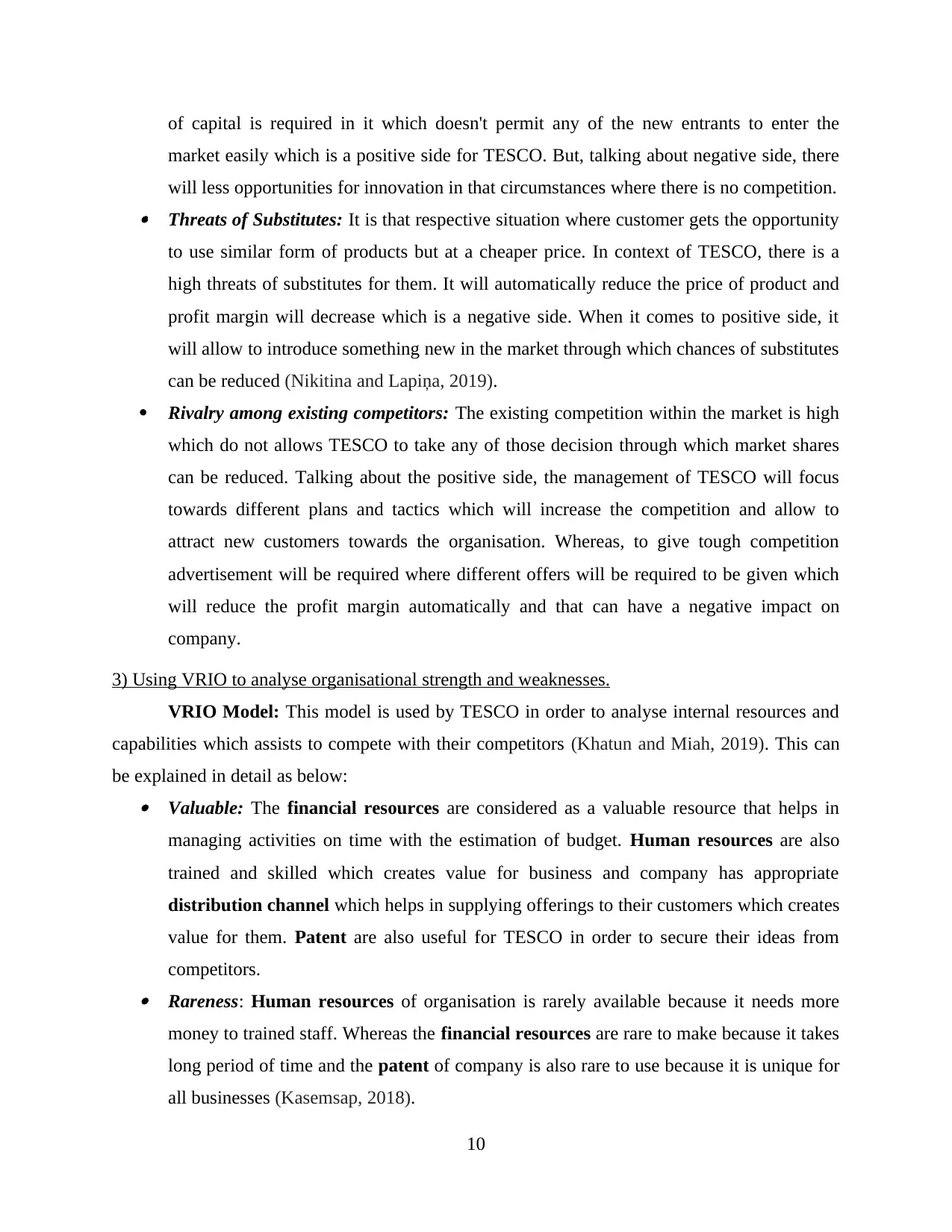
of capital is required in it which doesn't permit any of the new entrants to enter the
market easily which is a positive side for TESCO. But, talking about negative side, there
will less opportunities for innovation in that circumstances where there is no competition. Threats of Substitutes: It is that respective situation where customer gets the opportunity
to use similar form of products but at a cheaper price. In context of TESCO, there is a
high threats of substitutes for them. It will automatically reduce the price of product and
profit margin will decrease which is a negative side. When it comes to positive side, it
will allow to introduce something new in the market through which chances of substitutes
can be reduced (Nikitina and Lapiņa, 2019).
Rivalry among existing competitors: The existing competition within the market is high
which do not allows TESCO to take any of those decision through which market shares
can be reduced. Talking about the positive side, the management of TESCO will focus
towards different plans and tactics which will increase the competition and allow to
attract new customers towards the organisation. Whereas, to give tough competition
advertisement will be required where different offers will be required to be given which
will reduce the profit margin automatically and that can have a negative impact on
company.
3) Using VRIO to analyse organisational strength and weaknesses.
VRIO Model: This model is used by TESCO in order to analyse internal resources and
capabilities which assists to compete with their competitors (Khatun and Miah, 2019). This can
be explained in detail as below: Valuable: The financial resources are considered as a valuable resource that helps in
managing activities on time with the estimation of budget. Human resources are also
trained and skilled which creates value for business and company has appropriate
distribution channel which helps in supplying offerings to their customers which creates
value for them. Patent are also useful for TESCO in order to secure their ideas from
competitors. Rareness: Human resources of organisation is rarely available because it needs more
money to trained staff. Whereas the financial resources are rare to make because it takes
long period of time and the patent of company is also rare to use because it is unique for
all businesses (Kasemsap, 2018).
10
market easily which is a positive side for TESCO. But, talking about negative side, there
will less opportunities for innovation in that circumstances where there is no competition. Threats of Substitutes: It is that respective situation where customer gets the opportunity
to use similar form of products but at a cheaper price. In context of TESCO, there is a
high threats of substitutes for them. It will automatically reduce the price of product and
profit margin will decrease which is a negative side. When it comes to positive side, it
will allow to introduce something new in the market through which chances of substitutes
can be reduced (Nikitina and Lapiņa, 2019).
Rivalry among existing competitors: The existing competition within the market is high
which do not allows TESCO to take any of those decision through which market shares
can be reduced. Talking about the positive side, the management of TESCO will focus
towards different plans and tactics which will increase the competition and allow to
attract new customers towards the organisation. Whereas, to give tough competition
advertisement will be required where different offers will be required to be given which
will reduce the profit margin automatically and that can have a negative impact on
company.
3) Using VRIO to analyse organisational strength and weaknesses.
VRIO Model: This model is used by TESCO in order to analyse internal resources and
capabilities which assists to compete with their competitors (Khatun and Miah, 2019). This can
be explained in detail as below: Valuable: The financial resources are considered as a valuable resource that helps in
managing activities on time with the estimation of budget. Human resources are also
trained and skilled which creates value for business and company has appropriate
distribution channel which helps in supplying offerings to their customers which creates
value for them. Patent are also useful for TESCO in order to secure their ideas from
competitors. Rareness: Human resources of organisation is rarely available because it needs more
money to trained staff. Whereas the financial resources are rare to make because it takes
long period of time and the patent of company is also rare to use because it is unique for
all businesses (Kasemsap, 2018).
10
⊘ This is a preview!⊘
Do you want full access?
Subscribe today to unlock all pages.

Trusted by 1+ million students worldwide
1 out of 17
Related Documents
Your All-in-One AI-Powered Toolkit for Academic Success.
+13062052269
info@desklib.com
Available 24*7 on WhatsApp / Email
![[object Object]](/_next/static/media/star-bottom.7253800d.svg)
Unlock your academic potential
Copyright © 2020–2025 A2Z Services. All Rights Reserved. Developed and managed by ZUCOL.




